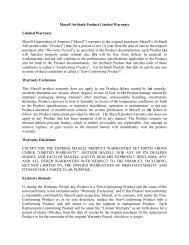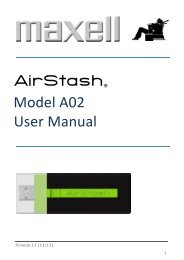1. Laminated Type Lithium-ion Rechargeable Battery - Maxell
1. Laminated Type Lithium-ion Rechargeable Battery - Maxell
1. Laminated Type Lithium-ion Rechargeable Battery - Maxell
You also want an ePaper? Increase the reach of your titles
YUMPU automatically turns print PDFs into web optimized ePapers that Google loves.
L<br />
i<br />
-<br />
i<br />
o<br />
n<br />
Li-<strong>ion</strong><br />
Secondary <strong>Battery</strong><br />
<strong>Lithium</strong>-<strong>ion</strong><br />
<strong>Rechargeable</strong> <strong>Battery</strong><br />
LITHIUM-ION RECHARGEABLE BATTERY<br />
Notes for Designers<br />
Select the correct type of battery to match the operating condit<strong>ion</strong>s<br />
such as load current, etc.<br />
The informat<strong>ion</strong> in this sect<strong>ion</strong> is for lithium-<strong>ion</strong> cells only. <strong>Maxell</strong><br />
offers these cells (excluding CLB) in battery pack format only.<br />
These include electronic circuits to prevent overcharge,<br />
overdischarge and so on. These battery packs are<br />
custom-developed and produced according to special<br />
requirements regarding operating condit<strong>ion</strong>s and specificat<strong>ion</strong>s.<br />
As a result, a minimum number of units may apply to such<br />
customized orders from customers purchasing battery packs. For<br />
details, consult your nearest <strong>Maxell</strong> dealer or distributor.<br />
Charge condit<strong>ion</strong>s<br />
To get the most out of lithium-<strong>ion</strong> batteries and use them safely,<br />
please read the following requirements carefully:<br />
Charge mode<br />
Charge voltage<br />
Max. charge current<br />
Charge time<br />
Charge temperature<br />
* As for cylindrical lithium-<strong>ion</strong> rechargeable batteries (high-power<br />
type), please consult your <strong>Maxell</strong> representative.<br />
Charge control flowchart (sample)<br />
Refer to the following flowchart when designing constant<br />
current and constant voltage battery chargers.<br />
Start charge<br />
Check battery connect<strong>ion</strong><br />
Check battery temperature<br />
Check battery voltage<br />
Passed<br />
Constant current, constant voltage charge<br />
• Current monitoring<br />
• Temperature monitoring<br />
• Time monitoring<br />
Passed<br />
Charge complet<strong>ion</strong><br />
Constant current, constant voltage charge (CCCV)<br />
4.20±0.05V / cell<br />
1I tA*<br />
Approx. 3 hours*<br />
0 to +45 deg. C<br />
Failed<br />
Preliminary charge<br />
Failed<br />
Abnormal charge stop<br />
Safety Instruct<strong>ion</strong>s<br />
Improper use of the battery may cause heat, fire, explos<strong>ion</strong>, damage or<br />
reduced battery capacity. Please read and follow the handling instruct<strong>ion</strong>s<br />
for the battery before and during usage. The followings are general<br />
caut<strong>ion</strong>s and guidelines only and as such may not include every possible<br />
usage scenario. The manufacturer will not be liable for act<strong>ion</strong>s taken or<br />
accidents caused.<br />
Danger<br />
Do not dip or wet the battery in water, seawater, or other liquid.<br />
Otherwise the battery may be shorted, which may generate heat<br />
or cause damage.<br />
Do not put the battery into a fire. Otherwise, the electrolyte may<br />
burn or cause an explos<strong>ion</strong>.<br />
Do not heat the battery. Otherwise the electrolyte may boil and<br />
resin parts may melt, causing leakage, explos<strong>ion</strong> or fire.<br />
The battery has a predetermined polarity. If the battery will not<br />
connect well to the charger or equipment, do not try to connect<br />
the battery forcefully. Check the polarity first. If the battery is<br />
connected in reverse, it will be charged in reverse and may cause<br />
leakage, heat generat<strong>ion</strong>, explos<strong>ion</strong> or fire due to an abnormal<br />
chemical react<strong>ion</strong>.<br />
Do not connect the battery in reverse relat<strong>ion</strong> to the positive (+)<br />
and negative (-) terminals in the charger or equipment. If the<br />
battery is connected in reverse, it will be charged in reverse,<br />
discharge excessive current and may cause heat generat<strong>ion</strong>,<br />
explos<strong>ion</strong> or fire due to an abnormal chemical react<strong>ion</strong>.<br />
Do not let the battery terminals (+ and -) come into contact with a<br />
wire or any metal (like a metal necklace or a hairpin) with which it<br />
is carried or stored. In such a case, the battery will be shorted and<br />
discharge excessive current, which may result in heat generat<strong>ion</strong>,<br />
explos<strong>ion</strong> or fire.<br />
Do not apply any heavy impact to the battery, throw or drop it.<br />
Otherwise the battery may be shorted and result in heat<br />
generat<strong>ion</strong>, explos<strong>ion</strong> or fire.<br />
3
LITHIUM-ION RECHARGEABLE BATTERY<br />
Do not drive a nail into, hammer or stamp on the battery.<br />
Otherwise the battery may be shorted and result in heat<br />
generat<strong>ion</strong>, explos<strong>ion</strong> or fire.<br />
Do not solder the battery directly. Heat applied during soldering<br />
may melt resin parts such as separator or gasket, and result in<br />
leakage, heat generat<strong>ion</strong>, explos<strong>ion</strong> or fire.<br />
Do not disassemble or alter the battery. Otherwise the battery may<br />
be shorted and result in heat generat<strong>ion</strong> or fire.<br />
Do not use or leave the battery near fire, heaters, inside an<br />
automobile in hot weather or under strong sunshine. Such<br />
condit<strong>ion</strong>s of high temperature may damage the separator, and<br />
the battery may be shorted and result in heat generat<strong>ion</strong>,<br />
explos<strong>ion</strong> or fire.<br />
When charging the battery, do not use any battery charger not<br />
specified by the manufacturer. Always follow the charge<br />
condit<strong>ion</strong>s specified by the manufacturer. If the battery is charged<br />
under other condit<strong>ion</strong>s (a high temperature, a high voltage/current<br />
or an altered charger) not specified by the manufacturer, the<br />
battery may cause heat generat<strong>ion</strong>, explos<strong>ion</strong> or fire due to<br />
abnormal chemical react<strong>ion</strong>s.<br />
Do not connect the battery directly to an electric outlet or cigarette<br />
lighter socket in a car. Applying a high voltage may generate an<br />
excessive current and cause an electric shock. In such a case, the<br />
battery may leak electrolyte, overheat, explode or cause fire.<br />
Warnings<br />
Do not put the battery in a microwave oven or a pressure cooker.<br />
Sudden heat may damage the seal of the battery and may cause<br />
heat generat<strong>ion</strong>, explos<strong>ion</strong> or fire.<br />
Do not use the battery together with a primary battery such as a<br />
dry battery or other battery of a different capacity, type and/or<br />
brand. In such a case, over-discharge during use or over-charge<br />
during charging may occur and abnormal chemical react<strong>ion</strong>s may<br />
cause heat generat<strong>ion</strong>, explos<strong>ion</strong> or fire from the battery.<br />
Caut<strong>ion</strong><br />
If the battery leaks and its electrolyte comes into contact with skin<br />
or clothes, wash the contact area well with tap water or other<br />
clean water right away. Otherwise skin may break out in a rash.<br />
When the battery is expected not to be used for a long time, take<br />
the battery out of the equipment or device and store it in a less<br />
humid area.<br />
After long periods of storage without being used, the battery<br />
should be charged before it is used. Charge the battery every 6<br />
months to the level specified by the manufacturer, even if the<br />
battery is not used.<br />
Do not leave the battery pack connected to the charger. It may<br />
cause the degradat<strong>ion</strong> of battery performance, such as a<br />
shortening of battery life.<br />
Turn off your equipment or device power switch after use.<br />
Do not use the battery in other than the following temperature<br />
ranges:<br />
Charge<br />
Discharge<br />
Storage (less than 30 days)<br />
Storage (less than 90 days)<br />
Notes for treating used batteries<br />
0 deg. C to +45 deg. C<br />
-20 deg. C to +60 deg. C<br />
-20 deg. C to +50 deg. C<br />
-20 deg. C to +35 deg. C<br />
• Insulate (+) and (–) terminals with tape.<br />
• Do not remove coating.<br />
• Do not expose to rain or water.<br />
• Do not disassemble.<br />
• Do not leave under strong sunshine.<br />
• Store in rugged receptacle and cover with a lid.<br />
L<br />
i<br />
-<br />
i<br />
o<br />
n<br />
If you notice any unusual odor, heat, discolorat<strong>ion</strong>, deformat<strong>ion</strong> or<br />
any other characteristic apart from what you are used to while<br />
using, charging or storing the battery, then take it out of the<br />
equipment or charger, and avoid using it. Using it in such state<br />
may result in heat generat<strong>ion</strong>, explos<strong>ion</strong> or fire.<br />
If the battery leaks or emits an unusual odor, remove it from the<br />
vicinity of any fire immediately. The electrolyte may catch fire,<br />
which may cause heat generat<strong>ion</strong> or explos<strong>ion</strong>.<br />
Do not let leaked electrolyte come into contact with the eyes. In<br />
the event of such contact, flush the eyes with plenty of water<br />
immediately and consult a doctor. Otherwise prolonged contact<br />
may cause serious injury.<br />
4
Li-<strong>ion</strong><br />
Secondary <strong>Battery</strong><br />
<strong>Laminated</strong> <strong>Lithium</strong>-<strong>ion</strong> <strong>Rechargeable</strong> <strong>Battery</strong><br />
Features<br />
Thin battery with large capacity<br />
Realizat<strong>ion</strong> of a thin, large-capacity lithium-<strong>ion</strong> rechargeable battery<br />
with an aluminum laminated sheet. Excellent heat transfer<br />
characteristics enable stable electrical performance and high-rate<br />
discharge.<br />
Cell Structure<br />
(+)<br />
(–)<br />
L<br />
i<br />
-<br />
i<br />
o<br />
n<br />
Safety and reliability<br />
<strong>Maxell</strong> offers a thermally stable positive electrode composit<strong>ion</strong><br />
drawing on its lithium-<strong>ion</strong> battery designing technique and thermally<br />
resistant separators with eliminated thermal contractility to enable<br />
excellent safety and reliability.<br />
Aluminum laminated sheet<br />
Applicat<strong>ion</strong>s<br />
Electric bikes<br />
Floor cleaners<br />
AGV (automated guided vehicle)<br />
UPS backup system, etc.<br />
Separators<br />
Negative electrode<br />
Positive electrode<br />
Products<br />
Model <br />
<br />
Dimens<strong>ion</strong>s* 1 Diameter <br />
(mm) Width <br />
Height <br />
Weight* 3 (g) <br />
Charge Max. voltage (V) <br />
(CCCV) Max. current (A) <br />
Discharge End voltage (V) <br />
(CC) Max. current* 4 (A) <br />
Nominal voltage (V) <br />
Minimum capacity* 5 (Ah) <br />
*1 Dimens<strong>ion</strong>s of fresh cell without tube *2 Measured without terminals *3 Approximate values<br />
*4 Please contact <strong>Maxell</strong> for condit<strong>ion</strong>s of use when using as assembled battery.<br />
*5 Measured under the following condit<strong>ion</strong>s: Charge CCCV: 1I tA/4.2V/2.5h, Discharge CC: 0.2I tA/E.V. = 2.75V, Temperature: 25 deg. C<br />
Characteristics (L13A0N2C1)<br />
Charge characteristics<br />
Charge capacity (%)<br />
100<br />
80<br />
60<br />
40<br />
20<br />
0<br />
Charge current (A)<br />
16.25<br />
13.00<br />
9.75<br />
6.50<br />
3.25<br />
Cell voltage<br />
Charge current<br />
0.00<br />
0 30 60 90 120 150 2.0<br />
Time (min)<br />
Discharge load characteristics<br />
Cell voltage (V)<br />
4.5<br />
4.0<br />
3.5<br />
0.2 ItA2.6 A<br />
Charge capacity<br />
Charge: 13A (1IA)/4.2V (CCCV)<br />
25<br />
1 ItA13 A<br />
2 ItA26 A<br />
3 ItA39 A<br />
3.0<br />
Charge: 13A 1ItA/4.2V CCCV/2h<br />
0.2ItA, 1ItA, 2ItA, 3ItA E.V. = 2.5V<br />
<br />
2.5<br />
0 5<br />
10<br />
15<br />
Capacity (Ah)<br />
4.5<br />
4.0<br />
3.5<br />
3.0<br />
2.5<br />
Cell voltage (V)<br />
8<br />
Discharge temperature characteristics<br />
Cycle life characteristics<br />
Capacity (Ah)<br />
14<br />
12<br />
10<br />
8<br />
6<br />
4<br />
2<br />
Charge: 26A2ItA/4.2VCCCV/0.65A cut<br />
Discharge: 26A2ItAE.V. = 2.5V<br />
Temperature: 25 deg. C<br />
0<br />
0 200 400 600 800 1000<br />
Cycle number (cycle)<br />
• Characteristics listed in this catalog are standard measured examples. <strong>Maxell</strong> does not guarantee these data. • Specificat<strong>ion</strong>s are subject to change without<br />
notice. • This data is for lithium-<strong>ion</strong> cells only. <strong>Maxell</strong> offers these cells in battery pack format only. These include electronic circuits to prevent overcharge, over<br />
discharge and so on. These battery packs are custom-developed and produced according to special requirements regarding operating condit<strong>ion</strong>s and<br />
specificat<strong>ion</strong>s. As a result, a minimum number of units may apply to such customized orders from customers purchasing battery packs.<br />
Cell voltage (V)<br />
4.5<br />
4.0<br />
3.5<br />
3.0<br />
45<br />
25<br />
0<br />
13A 1ItA/4.2V CCCV/2h/25<br />
13A 1ItAE.V. = 2.5V<br />
–10<br />
–20<br />
2.5<br />
0 5<br />
10<br />
15<br />
Capacity (Ah)
Transportat<strong>ion</strong> of <strong>Lithium</strong> Batteries and <strong>Lithium</strong>-<strong>ion</strong> <strong>Rechargeable</strong> Batteries<br />
Dangerous Goods Transportat<strong>ion</strong> Regulat<strong>ion</strong>s for <strong>Lithium</strong> Metal Cells and Batteries (*)<br />
The following are revised transportat<strong>ion</strong> regulat<strong>ion</strong>s:<br />
• Internat<strong>ion</strong>al Civil Aviat<strong>ion</strong> Organizat<strong>ion</strong> (ICAO) Technical<br />
Instruct<strong>ion</strong>s (ICAO-TI), 2011-2012 edit<strong>ion</strong><br />
Effective date: January 1, 2011<br />
• Internat<strong>ion</strong>al Maritime Organizat<strong>ion</strong> (IMO) Internat<strong>ion</strong>al Maritime<br />
Dangerous Goods (IMDG) Code, 2010 edit<strong>ion</strong><br />
Effective date: January 1, 2012<br />
It is important that necessary arrangements be made so that all<br />
those concerned are thoroughly informed of the revis<strong>ion</strong>s.<br />
The minimum requirements necessary to transport as<br />
non-restricted goods are as follows;<br />
1) For a lithium metal or a lithium alloy cell, the lithium content must<br />
not be more than 1 g. For a lithium metal or lithium alloy battery,<br />
the aggregate lithium content must not be more than 2 g.<br />
2) Each cell or battery must be of the type proven to meet the<br />
requirement of each test in the UN Manual of Tests and Criteria,<br />
5th revised edit<strong>ion</strong>, Part III, sub-sect<strong>ion</strong> 38.3.<br />
3) A battery handling label must be displayed on each package. A<br />
telephone number must be printed on the label for addit<strong>ion</strong>al<br />
informat<strong>ion</strong>.<br />
4) Each consignment must be accompanied by a document for<br />
transport* 1 with an indicat<strong>ion</strong> that:<br />
• the package contains lithium metal cells or batteries;<br />
• the package must be handled with care and that a<br />
flammability hazard exists if the package is damaged;<br />
• special procedures should be followed in the event that the<br />
package is damaged, to include inspect<strong>ion</strong> and repackaging if<br />
necessary; and<br />
• a telephone number for addit<strong>ion</strong>al informat<strong>ion</strong>.<br />
* 1 For air transport, the words “Not Restricted” and the<br />
above informat<strong>ion</strong> must be indicated on the Air Waybill.<br />
5) Each package must be capable of withstanding a <strong>1.</strong>2 m drop<br />
test.<br />
<strong>Maxell</strong> will offer the certificate of 1) and 2) as the need arises* 2 .<br />
Documentat<strong>ion</strong> for 3) and 4) need to be prepared by the<br />
customer. If our package is used for transport, we offer the<br />
certificate for 5) as the need arises* 2 .<br />
* 2 Please ask for the certificate through your normal purchase<br />
channels or sales representative.<br />
(*) <strong>Lithium</strong> metal cells and batteries:<br />
CR Cylindrical <strong>Type</strong> (<strong>Lithium</strong> Manganese Dioxide Batteries)<br />
Heat Resistant CR (<strong>Lithium</strong> Manganese Dioxide Batteries)<br />
CR Coin <strong>Type</strong> (<strong>Lithium</strong> Manganese Dioxide Batteries)<br />
ER (<strong>Lithium</strong> Th<strong>ion</strong>yl Chloride Batteries)<br />
ML Coin <strong>Type</strong> (<strong>Lithium</strong> Manganese Dioxide <strong>Rechargeable</strong> Batteries)<br />
TC Button <strong>Type</strong> (Titanium Carbon <strong>Lithium</strong> <strong>Rechargeable</strong> Batteries)<br />
Dangerous Goods Transportat<strong>ion</strong> Regulat<strong>ion</strong>s for <strong>Lithium</strong>-<strong>ion</strong> Cells and Batteries (*)<br />
The following are revised transportat<strong>ion</strong> regulat<strong>ion</strong>s:<br />
• Internat<strong>ion</strong>al Civil Aviat<strong>ion</strong> Organizat<strong>ion</strong> (ICAO) Technical<br />
Instruct<strong>ion</strong>s (ICAO-TI), 2011-2012 edit<strong>ion</strong><br />
Effective date: January 1, 2011<br />
• Internat<strong>ion</strong>al Maritime Organizat<strong>ion</strong> (IMO) Internat<strong>ion</strong>al Maritime<br />
Dangerous Goods (IMDG) Code, 2010 edit<strong>ion</strong><br />
Effective date: January 1, 2012<br />
It is important that necessary arrangements be made so that all<br />
those concerned are thoroughly informed of the revis<strong>ion</strong>s.<br />
The minimum requirements necessary to transport as<br />
non-restricted goods are as follows;<br />
1) For lithium-<strong>ion</strong> cells, the Watt-hour rating is not more than 20 Wh.<br />
For lithium-<strong>ion</strong> batteries, the Watt-hour rating is not more than<br />
100 Wh. The Watt-hour rating must be marked on the outside of<br />
the battery case except for those manufactured before January<br />
1, 2009.<br />
2) Each cell or battery is of the type proven to meet the<br />
requirement of each test in the UN Manual of Tests and Criteria,<br />
5th revised edit<strong>ion</strong>, Part III, sub-sect<strong>ion</strong> 38.3.<br />
3) A battery handling label must be displayed on each package. A<br />
telephone number must be printed on the label for addit<strong>ion</strong>al<br />
informat<strong>ion</strong>.<br />
4) Each consignment must be accompanied by a document for<br />
transport* 1 with an indicat<strong>ion</strong> that:<br />
• the package contains lithium-<strong>ion</strong> cells or batteries;<br />
• the package must be handled with care and that a<br />
flammability hazard exists if the package is damaged;<br />
• special procedures should be followed in the event the<br />
package is damaged, to include inspect<strong>ion</strong> and repackaging if<br />
necessary; and<br />
• a telephone number for addit<strong>ion</strong>al informat<strong>ion</strong>.<br />
* 1 For air transport, the words “Not Restricted” and the<br />
above informat<strong>ion</strong> must be indicated on the Air Waybill.<br />
5) Each package must be capable of withstanding a <strong>1.</strong>2 m drop<br />
test.<br />
<strong>Maxell</strong> will offer the certificate of 1) and 2) as the need arises* 2 .<br />
Documentat<strong>ion</strong> for 3) and 4) need to be prepared by the customer.<br />
If our package is used for transport, we offer the certificate for 5)<br />
as the need arises* 2 .<br />
* 2 Please ask for the certificate through your normal purchase<br />
channels or sales representative.<br />
(*) <strong>Lithium</strong>-<strong>ion</strong> cells and batteries:<br />
Prismatic lithium-<strong>ion</strong> rechargeable cells and batteries<br />
Cylindrical lithium-<strong>ion</strong> rechargeable cells and batteries<br />
<strong>Laminated</strong> type lithium-<strong>ion</strong> rechargeable cells and batteries<br />
Coin type lithium-<strong>ion</strong> rechargeable cells and batteries<br />
NOTE: For laminated type lithium-<strong>ion</strong> rechargeable cells, the watt-hour rating is<br />
over 20 Wh and therefore the cells must be shipped as class 9 dangerous<br />
goods. For more informat<strong>ion</strong>, see the latest vers<strong>ion</strong> of ICAO TI, IATA DGR and<br />
IMDG Code.<br />
51
Catalog contents accurate as of February 2012.<br />
Data and dimens<strong>ion</strong>s are just reference values.<br />
Contents on this catalog are subject to change without notice.<br />
Committed to the highest quality assurance management standards as well as responsibility to the environment,<br />
<strong>Maxell</strong>'s Batteries product<strong>ion</strong> facilities are accredited with both ISO 9001 and ISO 14001 certificat<strong>ion</strong>s.


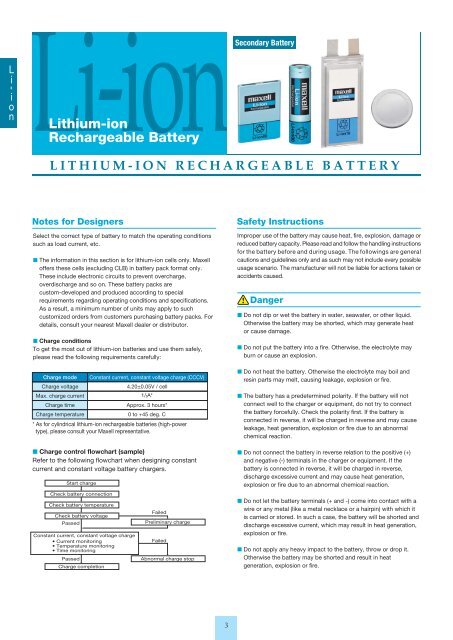

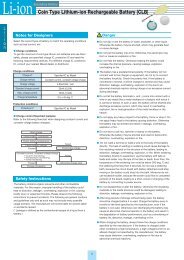


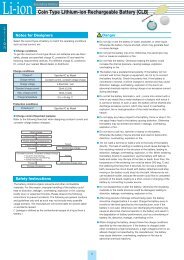
![CLB 电池å•元目录[PDF 1.07MB] - Maxell](https://img.yumpu.com/33415090/1/190x257/clb-aaauaaa-aaaoaaaaaaraa-1-2-aopdf-107mb-maxell.jpg?quality=85)
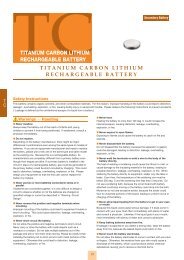
![Cylindrical CR catalog [PDF 1.61MB] - Maxell](https://img.yumpu.com/32837016/1/184x260/cylindrical-cr-catalog-pdf-161mb-maxell.jpg?quality=85)
